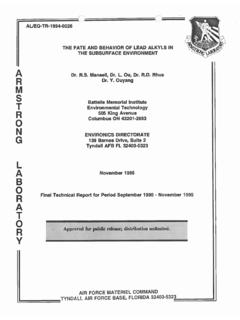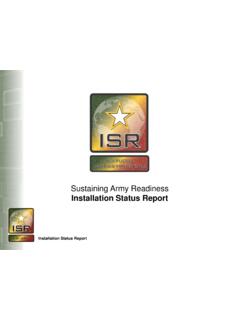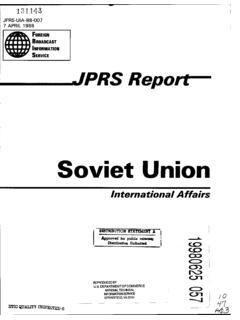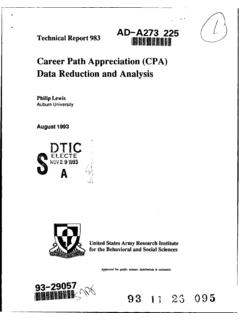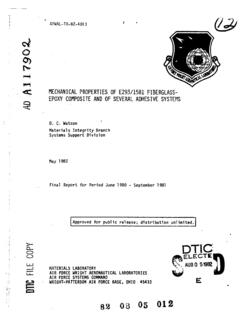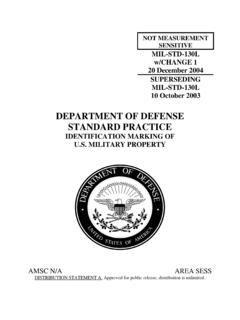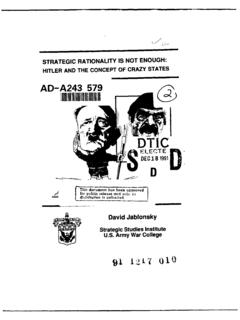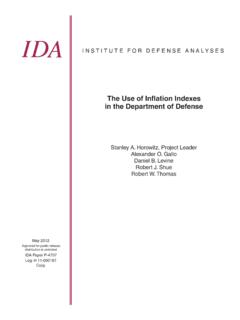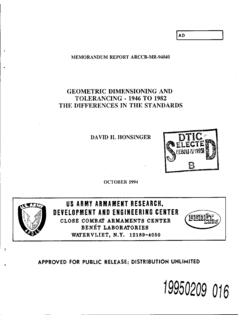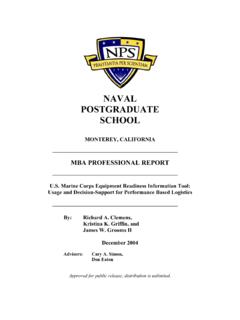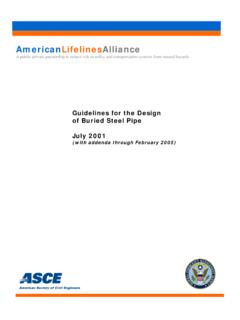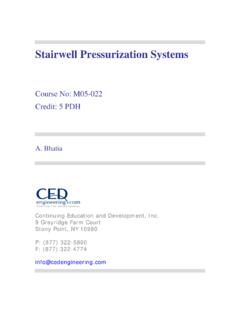Transcription of Density of Solids and Liquids - apps.dtic.mil
1 U TDSTIATE'S D)EPARTMENT OF' COMMERCE 9 Charles Sawyer, SiecrearyUNITE!) NXV[ONAI. BUREAU OF SrANI)AIDS e E. U. Condon. Dirteta, Density ofSolids and Liquidsby Peter Hidnert and Elmer L. PefferAccesion ForNTIS CRA&IOTIC TABU nannouncedJustificationDit Availl and/ orr~s Spe cialNational Bureau of Standards Circular 487 Issued March 15, 1950 Office WasXY 11Pu~blished Recently..Thermal Expansion of SolidsTen methods for determining thermal expansion of Solids are givenin this new Circular, which presents the procedures used to obtainexpansion equations and coefficients of expansion of materials.]
2 Someapplications of thermal expansion are between thermal expansion, temperature, chemicalcor position, Density , compressibility, specific heat, melting point,atomic weight, and other properties of materials are discussed.()rcr NBS Circular 486, Thermal Expansion of Solids , 29 two-column pages, illustrated, from the Superintendent of Documents,U. S. Government Printing Office, Washington 25, D. C. Price20 is ono of the significant physical properties of materialsthat is important in science and Circular is issued to supply a demand for information for determinations of the densities of Solids andliquiids.
3 Circular also indicates that Density determinations-may ber used to identify materials, and to obtain relationshipsbetween Density , chemical composition, thermal and mechanicaltreatments, Bureau has published during the past four decades of-investigations on the densities of various materials. Alist of. these publications will be sent upon request to U. CONDON, Introduction---------------------------- ---------------11. Definitions and terms------------------------------1II. Types of apparatus for Density determinations ------------------31.
4 Hydrostatic weighing method ------------------------ 3(a) Solids ---------------------------------- 3(b) Liquids ----------------------------------32. Picnometer method------------------------------- 8(a) Liquids ----------------------------------8(b) Solids ----------------------------------143. Flotation method --------------------------------154. Hydrometer method ---------------------------- 185. Falling-drop method ----------------------------------- 226. Balanced-column method ------------------------------- 247. Method based on Boyle's law -----------------------248.
5 Electromagnetic method --------------------------- 259. Elastic helix method ----------------------------------- 2610. Ice calorimeter method ---------------------------- 2711. Volumetric method -------------------------------27 III. References ---------------------------------------- ----------- 28 IIID ensity of Solids and Liquidsby Peter Hidnert and Elmer L. Peffer* Density data may be used for obtaining relationships between Density , chemical com-position, thermal and mechanical treatments of materials, etc. This circular defines densityand specific gravity, describes 11 methods (hydrostatic weighing, picnometer, flotation,hydrometer, falling drop, balanced column, Boyle's law, electromagnetic, elastic helix, icecalorimeter, and volumetric) for determinations of the densities of Solids and Liquids , andindicates the accuracy of various Introduction1.
6 Definitions and Terms stance. Care must be taken, however, to statethe units employed and the temperatures in- Density is a significant physical property of volved, otherwise there is danger of confusion andmaterials, and is important in science and in- misinterpretation of The extensive literature on Density Specific gravity may be determined at anyshows that determinations of the Density of ma- convenient temperature and referred to waterterials is a constant and recurrent problem. at any desired temperature. For example , spe-For example , Density determinations may be used cific gravity may be determined at 200 C andto identify materials, and to obtain relationships referred to water at 200, 15', 40 C, or any otherbetween Density , chemical composition, thermal temperature.
7 It is then expressed as specificand mechanical treatments of materials, etc. gravity at 20'/20' C, 200/150 C, or 200/4' any list of the physical properties of a sub- If determined at 25' C, the specific gravity isstance, its Density or specific gravity is usually expressed as 250/200 C, 250/150 C, or 250/4 If the values of the Density of a sub- Specific gravity is often expressed in terms ofstance are to be relied upon when obtained by water at the same temperature as that at whichdifferent observers or by different methods, it is the substance is weighed.
8 For example , 150/150 C,important that they be both accurate and com- 200/200 C, or 250/250 C. It is preferable, how-parable. ever, especially in the case of Liquids , to expressDensity is the mass per unit volume and is all specific gravities in terms of water at 40 expressed in grams per cubic centimeter The values are then directly comparable, since(or per milliliter)' at some definite temperature. they are measured in terms of the same unit, andSpecific gravity is an abstract number expressing if the change of specific gravity per degree changethe ratio of the weight of a certain vblume of the of temperature is known they may all be easilymaterial in question to the weight of the same reduced to the same temperature.
9 There is alsovolume of some other substance taken as standard the additional advantage that specific gravitiesat a stated temperature. Water is usually used when so expressed are numerically the same asas the standard substance. Both the temperature densities in grams per milliliter. For example ,of the material and the temperature of the standard specific gravity at 20'/40 C is numerically thesubstance should be indicated, same as Density at 200 C expressed in grams perDensity and specific gravity, while funda- milliliter.
10 This is obvious, since, by definition,mentally different, are nevertheless determined 1 milliliter of water at 40 C weighs 1 the same way and may have the same numerical In making specific gravity determinations on avalues. The two terms are often used synony- series of samples of the same kind, it is likely thatmously as expressing the "heaviness" of a sub- the temperatures of the various samples will differDeceased. somewhat unless a constant temperature bath isS The cubic centimeter (that is, the volume of a cube 1 cm on a side) is not used.
